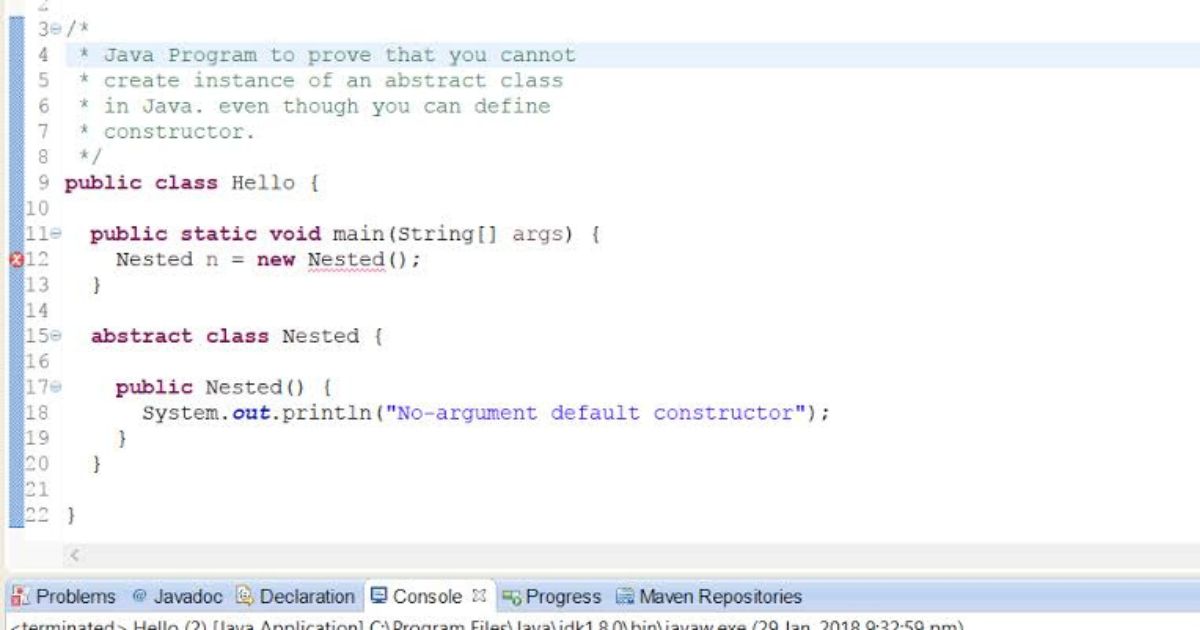In object-oriented programming (OOP), classes are the blueprints for creating objects, and they can either be abstract or concrete. An abstract class is a class that cannot be instantiated on its own but must be inherited by other classes. It is designed to provide a common interface and functionality for its subclasses, but it is not intended to be used directly to create objects.
The question “how many instances can be created for an abstract class” is a fundamental query in OOP, especially when dealing with inheritance and polymorphism. To answer this question comprehensively, it’s essential to first understand the concepts of abstract classes, their purpose, and how they function in object-oriented programming languages like Java, C++, Python, and C#. This article will explore abstract classes, how they are used, and clarify the limitations and rules about instance creation in the context of abstract classes.
What is an Abstract Class?
An abstract class is a class that cannot be instantiated directly. In other words, you cannot create an object from an abstract class. Instead, it serves as a blueprint for other classes that extend it. An abstract class may contain both abstract methods (methods without an implementation) and concrete methods (methods with an implementation). The abstract methods must be implemented by any concrete subclass, while concrete methods can be inherited as-is or overridden in the subclass.
Key Characteristics of Abstract Classes:
- Cannot Be Instantiated: An abstract class cannot be used to create objects directly. This is one of the key features that distinguishes abstract classes from regular (concrete) classes.
- May Contain Abstract Methods: Abstract methods are those that are declared but not defined in the abstract class. Subclasses must implement these methods.
- May Contain Concrete Methods: These methods have full implementations and can be inherited by subclasses.
- Can Have Constructors: Even though an abstract class cannot be instantiated, it can have constructors to initialize its state when objects of the subclasses are created.
Example of an Abstract Class in Java:
abstract class Animal {
// Abstract method (no implementation)
abstract void sound();
// Concrete method
void breathe() {
System.out.println("Breathing...");
}
}
class Dog extends Animal {
// Implementing abstract method
void sound() {
System.out.println("Bark");
}
}
In the example above, the class Animal is abstract and cannot be instantiated. However, Dog is a concrete class that extends Animal, and it must provide an implementation for the abstract method sound(). We can create instances of Dog, but we cannot create an instance of Animal directly.
How Many Instances Can Be Created for an Abstract Class?
The direct answer to this question is none. An abstract class cannot be instantiated directly. It is designed to be inherited by other classes, and those subclasses can create instances. The role of an abstract class is to provide common functionality or a common interface to its subclasses, which will then implement the abstract methods and potentially override the concrete ones.
To understand why no instances can be created from an abstract class, consider the following:
- Abstract Nature: The whole idea of an abstract class is that it is incomplete. Since it may contain abstract methods (which have no body), it is not considered a complete implementation on its own. This incompleteness prevents it from being instantiated.
- Dependency on Subclasses: Since an abstract class is meant to be a foundation for other classes, an instance of an abstract class would not make sense because there is no guarantee that it would have the necessary implementations to function correctly. The actual behavior and properties of objects created from an abstract class depend on the concrete subclass that implements it.
Example in Java:
In Java, if you try to instantiate an abstract class, the compiler will throw an error.
abstract class Vehicle {
abstract void drive();
}
public class Test {
public static void main(String[] args) {
// Trying to instantiate the abstract class
Vehicle v = new Vehicle(); // Compilation error: Vehicle is abstract; cannot be instantiated
}
}
In the above code, trying to create an instance of Vehicle directly would result in a compilation error because Vehicle is abstract.
Abstract Classes and Inheritance
Abstract classes play a significant role in inheritance hierarchies. They allow you to define common behaviors for subclasses but force those subclasses to implement abstract methods. Even though an abstract class cannot be instantiated, its subclasses can be.
Creating Instances of Subclasses:
You can create an instance of a subclass that extends an abstract class. For example, in the Java example above, Dog extends Animal, so you can create an instance of Dog, but not Animal.
Dog dog = new Dog(); // Valid, as Dog is a concrete subclass of Animal
In this case, Dog provides concrete implementations of all the abstract methods declared in Animal, so it can be instantiated. However, since Animal is abstract, trying to create an object of type Animal would lead to a compilation error.
Abstract Class with Multiple Subclasses:
An abstract class can have multiple subclasses, and each subclass can create multiple instances. Each of these subclasses can create any number of objects, depending on the design and requirements of your program.
class Cat extends Animal {
void sound() {
System.out.println("Meow");
}
}
public class Test {
public static void main(String[] args) {
Dog dog = new Dog(); // Valid
Cat cat = new Cat(); // Valid
}
}
In the above example, both Dog and Cat are concrete classes that inherit from Animal. You can create multiple instances of Dog and Cat, but you still cannot instantiate Animal directly.
Why Can’t You Create an Instance of an Abstract Class?
There are several important reasons why you cannot create an instance of an abstract class:
- Incomplete Implementation: An abstract class typically represents an incomplete abstraction that needs to be extended by concrete classes. Allowing instantiation of an abstract class would defeat its purpose of providing a base for other classes to complete the implementation.
- Ensuring Consistency: By requiring subclasses to implement abstract methods, an abstract class ensures that all subclasses will adhere to a specific contract or interface. If you could create an instance of the abstract class directly, there would be no guarantee that the object would have all necessary behaviors implemented.
- Design Principle: The purpose of abstract classes is to represent a generalized concept that is too broad to instantiate on its own. For example,
Animalis an abstract class, and you cannot create a genericAnimalobject because an animal could be any species with specific characteristics. By abstracting the class, you ensure that the implementation is tailored to specific subclasses likeDog,Cat, etc.
Conclusion
In summary, the answer to the question of how many instances can be created for an abstract class is straightforward: none. Abstract classes cannot be instantiated directly because they are incomplete by design. Instead, they serve as a foundation for other classes that implement the abstract methods and provide concrete behaviors. Instances can only be created from concrete subclasses that extend the abstract class.
The key takeaway here is that abstract classes are powerful tools in object-oriented programming that allow for the definition of common interfaces and functionality across multiple subclasses. They enforce a contract that subclasses must adhere to, ensuring consistent behavior while enabling flexibility in the implementation.
If you’re working with abstract classes, remember that the purpose of using an abstract class is to provide a structure for subclasses to follow, rather than creating direct instances of the abstract class itself. By understanding the role and limitations of abstract classes, you can design cleaner, more maintainable code in your object-oriented projects.










